





PHOTO GALLERY

Photos by Len Blumin
1. Greater Scaup
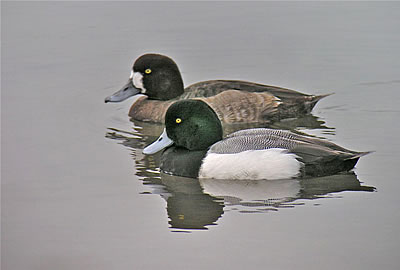
Lots of "Bluebills" around these days, meaning the Scaups. These two Greater Scaup (Aythya marilia) were in the Loch Lomond Marina on January 7, part of a group that were congregating socially but had not yet formed pair bonds (they do that later than most ducks around here). Just happened to get them together for a second, to show the contrast between male and female. They were pretty close to me, but separated too much from each other for both to be in focus. The male Greater Scaup has a green gloss on the head in the right light (barely seen here), coarse vermiculations on his back, a very pale "clean" flank, and a big blue bill. The black swollen tip of the bill is the "nail", and is larger in the Greater Scaup. Greater Scaup has a more rounded head, but can show a slight bump near the rear of the crown, as here. But note how the back of the head (occiput) is nicely rounded. The female here shows a more typically rounded head, as well as a larger nail on the bill.
Greater Scaups winter along both coasts in North America, although more along the east coast, such as Long Island Sound. Here not many go much further south than San Francisco Bay. In contrast, Lesser Scaups are found much more widely, including inland areas and waters well to the south into Mexico. Both Scaups form their pair bonds in Feb/March, sometimes shortly before leaving. The Greater will go mostly up to Alaska and northwest Canada. Greater Scaup is the only circumpolar or "holarctic" Pochard (Aythya). When they disperse south after breeding most (70-80%) will fly southeast, taking the longer journey to the east coast. Lesser Scaup are much more numerous overall. The male Lesser can show a pretty purple gloss on the head, has a slightly smaller bill, and a flatter occiput, with a more pronounced bump on the crown, producing a slightly squarish look. In flight the Greater Scaup has a white stripe near the trailing edge of the wing that extends further out into the primaries than the stripe on the Lesser.
2. American Pipit - Anthus rubescens
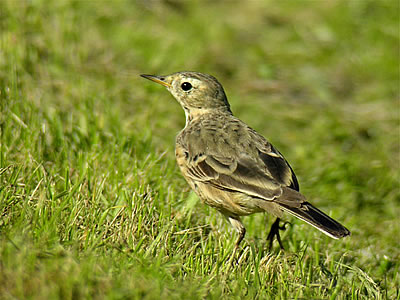
Pipits are often described as dull, but they're always fun to watch as they tail-bob along, foraging in the grass for insects and other prey. Taken March 6, at Shorebird Marsh, Corte Madera. American Pipets are often seen near the water (once called Water Pipit), but can be found in a wide range of open habitats, including the beach. The Pipits (about 42+ sp.), Wagtails (12 sp.), and Longtails (7 sp.), together make up the family Moticillidae, the Pipits and Wagtails. Most are Old World and not closely related to North American passerine families. I liked this photo because of detail in the coverts and secondaries, seen over the lower back. Typical head up posture. We can't see the long legs and long claws very well here, but the white outer tail feathers are shown clearly.
3. Whiskered Screech Owl
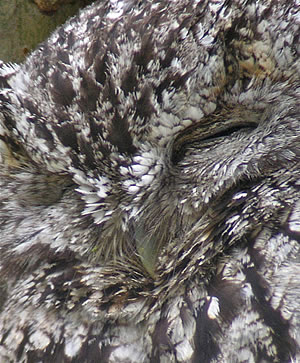
The "whiskers" of the Whiskered Screech-Owl (Megascops trichopsis) refer to the bristly extensions of some of the feathers of the facial disc, which are said to be longer that those on other Screech-Owls. "Trichopsis" means roughly "hairy face". Here is an enlarged view of the face in an attempt to better show the bill and facial disc bristles, perhaps seen best below the left eye and towards the bill.
4. Vermilion Flycatcher
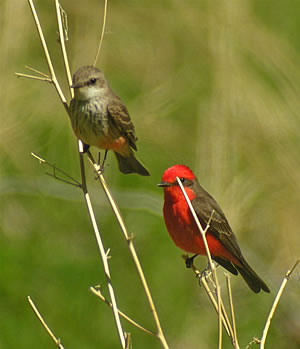
Male and female Vermilion Flycatchers on a dry stalk along the San Pedro River. Even Photoshop cannot remove the offending dead stalk, but at least we get a decent look at the female, with a streaky breast and apricot orange vent area ("underpants", as Mark P. would say), and a white throat. Say's Phoebe has more extensive apricot, lacks streaking on the breast and has a gray throat.
5. Blue Crow at Mono Lake
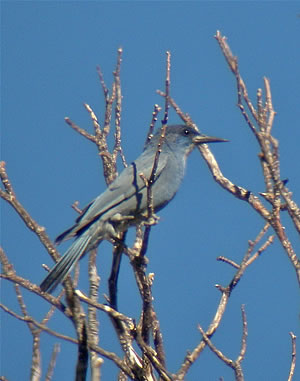
Ah, the notorious Crow Family (Corvidae, which includes Crows, Ravens, Jays, Magpies, et. al.). They number 118 species, in 24 genera. The "Blue Crow" was sometimes used as the common name for Pinyon Jay, the only species in the genera Gymnorhinus. Most corvids have modified feathers on the proximal bill, known as nasal bristles. The Pinyon Jay (Gymnorhinus cyancephalus) lacks any nasal bristles (gymnorhinus = naked beak), and the bill is much straighter and longer than that on the typical corvid.
Don't expect much detail in the photo. Pinyon Jays are rather shy and wary, even posting sentinels to watch over what is sometimes a very large flock feeding on the ground. We were at Mono Mills right after the PRBO trip with Rich Stallcup. A large (100+) flock of Pinyon Jays flew in, calling noisily. Leslie Flint echoed the "caw" and soon it seemed that one particular bird responded each time Leslie called out. Quite funny. Most of the flock came to feed on the ground about 50 yards away, which is about as close as you can usually get to this clever species. The bird shown here stayed high on a tree about 120' away, perhaps one of the watchers for the group. You can't reliably find Pinyon Jays at any given location, as they roam widely in search of food. Their communal nomadic behavior is not common among corvids, and reminded me of flocks of Waxwings. This is one very cool and pretty corvid.
6. Northern River Otter - Lontra canadensis
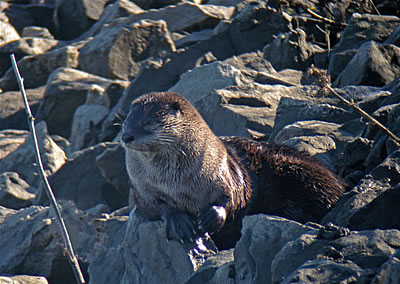
"So, just what is an 'otter' anyway," I asked myself this morning. I kind of knew from outings with Rich Stallcup that the otters are 'mustelids', but figured I 'd better learn a lot more.
My handy reference, Mammals of North America (Petersen Field Guides, Fiona Reid) gives a brief introduction, but the Wiki account is well-written and more extensive:
http://en.wikipedia.org/wiki/North_American_River_Otter
So, it turns out that the Northern River Otter is a member of the Weasel family, (Mustelidae). The mustelids are a family in the order Carnivora, which of course is in the class Mammalia.
Worldwide there are 56 mustelid species (none in Australia, though), of which 11 are seen in the U.S. and Canada. Ours include American Marten, Fisher, Least Weasel, Ermine, Long-tailed Weasel, American Mink, Black-footed Ferret endangered species), Wolverine (Gulo gulo!!), American Badger, and the 2 otters, Northern River Otter and the Sea Otter. All but the Ferret and Least Weasel have can be seen in California, but not easily!
The 'otters' comprise the Lutrinae subfamily within the mustelids, and the Northern River Otter is in the genus Lontra, species Lontra canadensis, and subspecies (there are 10) L. c. pacifica.
I didn't know that the River Otter needs to keep swimming to keep its head above water, and does so by paddling with all four paws. They prefer to eat fish and crustaceans, but are very opportunistic, as seen locally by their extensive predation of birds at Rodeo Lagoon, including Brown Pelican. They are often seen at the Las Gallinas water treatment ponds, as this one which was basking and preening on the riprap of pond #2 recently. Harsh lighting limited the photo quality, though.
TOWHEE.NET: Harry Fuller, 820 NW 19th Street, McMinnville, OR 97128
website@towhee.net